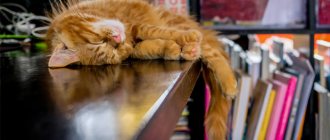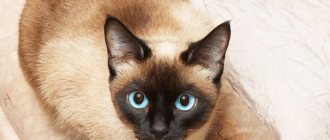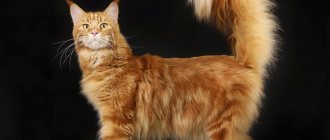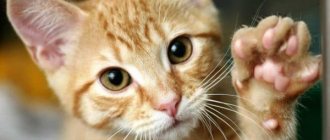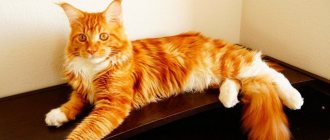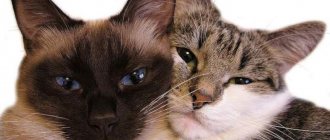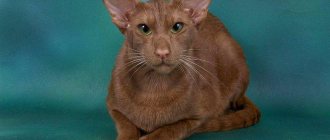The Maine Coon or American raccoon cat is an indigenous breed native to North America, from the state of Maine, bordering Canada. The name of the breed comes from the name of this state (Maine). The second part of the name (“kun”) was added already in the 20th century and is derived from the word “rekun” (from the English racoon - “racoon”). Maine Coons are considered the largest breed of domestic cats in the world and one of the most popular today.
“The raccoon cat from Maine” has long lived on farms near humans and its responsibilities included protecting grain and supplies from rodents. It is only natural that these intelligent animals found their way to the hearts of their owners and became dearly loved as pets, and not just as useful and good workers. This cat most likely resulted from crossbreeding of domesticated shorthaired and longhaired cats brought with the first ships of European settlers and traders from Asia Minor to Maine and other parts of New England at a time when cats were not yet registered.
Maine Coons are the natural population of the American cat metropolis. Nature took part in its creation for many years, which made these cats strong, physically resilient animals. Living semi-wildly on farms, in villages, and often just on the streets, these intelligent cats were able to survive by adapting to the harsh New England climate so that they could breed again the following season. When creating a cultural breed, breeders only have to consolidate these factors.
The favorite pastime of rural residents in those days were fairs with various competitions: cowboy competitions, dog and cockfights, horse racing. But not only gambling competitions were popular. American “gigantomania” has given rise to the desire to grow the biggest pumpkin, the biggest bull, the biggest cat. During the 1850s and 1860s, such competitions became so popular that farmers created their own cat show at the Skowhegan Fair, where only Maine Coon ancestors competed for the title of "Maine State Champion Coon Cat." Perhaps those first fair entertainments gave the first impetus to selection - competing farmers sought to get the biggest cats.
Biography
Ron Perlman is a Hollywood star who gained fame after the release of Hellboy: Hero from Hell and Hellboy 2: The Golden Army.
The boy was born in New York into a family of Jewish immigrants on April 13, 1950. The child was given the name Ronald Francis Perlman at birth. His parents worked in the municipality, but his father was fond of jazz and even participated in performances of a musical group. Since childhood, Ron was distinguished by his heavy weight and heavy figure. Because of this, his peer society considered him an outcast. The future artist’s main friend and adviser throughout the years was his father.
Ron Perlman in his youth and adulthood
His passion for theater helped the young man become a popular person. After graduating from Lehman College, where Ron, in addition to studying at the Faculty of Fine Arts, participated in productions of an amateur theater group, the young man, on the advice of his father, entered the University of Minnesota to study acting. In 1973, the young man graduated from university with the status of a master of theater arts.
Appearance
From a young age, Ron Perlman had an unconventional appearance. With a height of 185 cm, the actor’s weight is 88 kg. Ron's lower jaw appears disproportionately large, and his left eye, as seen in photographs, is smaller than his right. Fans and critics note that the actor looks like a Neanderthal or a native.
Ron Perlman resembles a Maine Coon cat
Ron is credited with resemblance to the Maine Coon cat breed, which for a long time was brought to North America and settled throughout the United States. A lot of photos and jokes are being circulated on the Internet about Ron’s resemblance to a representative of the fauna. But Ron himself regards his peculiar popularity with humor: the artist has long ceased to perceive the features of his appearance as a disadvantage.
Legends about the origin of the Maine Coon breed
As with many cat breeds, the early history of the breed is shrouded in mystery and legend. It is possible that in those early days, Maine Coons lived freely and got their name from their raccoon-like appearance and habits. Both are distinguished by long fur, and since tabby coloring is often found among outbred cats, the resemblance to a raccoon increases. Next is the area of legends that those same cats crossed with the North American lynx (a “strong argument” in favor of this version is the well-known delightful tufts on the ears of the Maine Coon), or even with a raccoon (part of the name “coon” is in favor of this version "- racoon in translation means "raccoon", as well as a wide fluffy tail and a color reminiscent of a raccoon). The versions are extremely romantic and attractive, but have no basis due to species differences and the impossibility of interspecific crossings. There are many legends about the origin of the Maine Coon breed from cats brought by sailors to the American continent. Some felinologists believe that raccoon cats are descended from Norwegian forest cats, which were brought to the American continent back in the 2nd century. Vikings. Others believe that Maine Coons were brought to North America from Asia Minor. Sailors took the ancestors of modern Maine Coons with them because of their excellent hunting instincts, as they were excellent catchers of rats and other rodents. Since there was always enough work for them in the holds of ships, these cats could well become permanent companions of humans on sea voyages. The state of Maine at that time was a large commercial center with intensively developing trade. From ships, cats could easily have reached the continent and spread throughout the state. There is written evidence that large ship rat-catching cats landed on the continent from sea ships during their stay. They also mention that sailors often, keeping a small kitten for themselves, gave the old cat on the shore into good hands.
Marie Antoinette One of the legends says that the American continent owes its long-haired cats to Marie Antoinette. During the French Revolution, the queen decided to flee France to America. Captain Samuel Cloa was preparing the escape of the disgraced queen. The ship was loaded with everything that the queen, a well-known fan of luxury, considered necessary to take with her on the trip: luxurious furniture, expensive trinkets and the queen's six beloved cats. But fate decreed otherwise. The escape failed, the queen was executed, and the captain was forced to flee for fear of persecution. This is how the cats of the disgraced queen found their way to the American continent, where they found their new home and were accepted into the society of short-haired cats that arrived on the continent earlier.
Another, but slightly less romantic version tells that there once lived an English captain nicknamed “Raccoon” (Kun), known for his adoration of cats and not setting sail without his purring retinue. His ship was inhabited by a huge number of expensive cats, primarily Persian and Angora. The captain made trips to the shores of America. People who received kittens from this ship, for obvious reasons, said “these kittens are from the Raccoon.”
There is another legend - about a cabin boy named Tom Kuhn, who served on Glen Lowry's ship. This ship stopped near Tarbox Farm in Maine, where a boy sold long-haired cats to farmers. He then sold several more cats on the same farm. The owner of the farm, Lida Choate, was breeding cats and became very interested in the powerful ship cats. They became the founders of the Maine raccoon cat breed. The first cats were named Yani and Jennifer. Numerous offspring were obtained from them; the word Choate (the breeder's surname) or Tarbox (the name of the farm) was added to the names of the kittens. Although there is no evidence that raccoon cats were introduced by Captain Coon (or a cabin boy of that name), Lida Choate cats became very famous in Maine. She may have been the first breeder of this breed and also gave the Maine Coon its name.
There is an opinion that Maine Coons were not brought to the American continent. The ancestors of this breed were large and massive aboriginal cats that were originally found in North America. These cats led a semi-wild lifestyle, for which they were perfectly adapted.
"Hellboy"
Exactly 11 years after the first collaboration, Guillermo del Toro invites his favorite performer to a new project called “Hellboy”. The script for the mystical thriller was written based on the plot of the famous comic book by Mike Mignola. According to the producers, the main role was intended for Vin Diesel, but the director only saw Ron Perlman in the role of Hellboy. In the actor’s biography, the film about a guy from hell became his high point.
Ron Perlman in the movie "Hellboy"
Contrary to expectations, the film not only failed at the box office, but also brought the authors $100 million and a Saturn statuette for best makeup work. Four years after the first part of the franchise, Hellboy: Hellboy, the second film, Hellboy 2: The Golden Army, was released, which received the Saturn Award in the category “Best Horror Film”, and the work of the make-up artists was re-evaluated. but this time already by film critics of the Oscars.
Voice acting
Ron Perlman is known not only for his unusual appearance, but also for his strong, thick bass voice. Therefore, in addition to the film set, the actor also appears in a dubbing studio. Perlman has worked in the cartoons Mortal Kombat: Defenders of the Earth, Teen Titans, Bae, Afro Samurai, Justice League and Justice League: Without Borders, Adventure Time and The Book of Life.
Ron also worked on the dubbing of the cartoons “Hellboy: Sword of Thunder” and “Hellboy: Blood and Metal.” The narrator communicates with the players of the post-apocalyptic game “Fallout” in his voice. Ron has also provided voice work for other computer games: Halo 2 and Halo 3, Turok, Justice League Heroes and Incredible Hulk: Ultimate Destruction.
Personal life
Ron Perlman tries not to advertise his private life in the press and on the Internet. It is known that the actor has been happily married to Opal Stone since 1981.
Ron Perlman and his wife
Ron Perlman, despite his terrifying appearance, turned out to be a real romantic: the actor married Opal on Valentine's Day. Three years later, his wife gave birth to a daughter, Blake Amanda, and 6 years later, a son, Brandon Avery.
Ron Perlman today
In the summer of 2020, a new video game “Payday 2” was released, in which Ron voiced the character Rust, who is engaged in theft. In 2020, Ron made his debut as a producer: under the direction of Perlman, the comedy Pottersville was released. The actor’s latest film roles were in the thriller “The Blacklist,” an adaptation of the novel “Fantastic Beasts and Where to Find Them.”
In 2020, the films “Asher”, “Jesuit”, “Sergio and Sergei” are being prepared for release. At the end of 2020, Ron Perlman launched a comic election campaign on the Internet in which he urged viewers to vote for him in the 2020 presidential election. Fans appreciated Ron Perlman's sense of humor, and the video received 400 likes.
The Maine Coon is a native cat breed that originated in the United States. Its development and formation took place mostly in Europe, where breeders and breeders developed new lines of animals, securing in them certain character traits and external characteristics inherent in modern Maine Coons. This led to the emergence of two intrabreed varieties: American and European.
Features of feeding and diet
Your pet's diet should include all the following:
- proteins are essential components for ensuring the good functioning of all organs, for growth and well-being;
- carbohydrates are a source of energy;
- fats are a source of energy and a component for the formation of immunity;
- vitamins and minerals.
The most important thing in purchased food is the presence of a meat ingredient in the composition in the first place. It should not contain many preservatives (it is better if they are absent altogether), so it is advisable to buy food from professional brands.
As for homemade food, the majority should be meat products: chicken, turkey, beef. You can also include cereals, vegetables, low-fat dairy products, and eggs in your diet. In pet stores you can buy a special grass - sprouted grain crops.
When choosing a diet, you should take into account the size of cats, because they are very different from other breeds. If this is your first time, consult your veterinarian or breeder for advice.
American type
Maine Coons are the American type - classic representatives of the breed . Breeders from the USA strive to preserve their purebredness and original appearance, so individuals with similar external characteristics are selected for crossing. Aboriginal cats have a number of characteristic features that distinguish them from other cats when compared:
- strong bones;
- developed muscles;
- wide chest;
- small, high-set ears;
- Round eyes;
- long whiskers that helped cats in the wild navigate in the dark;
- wide head with a noticeable transition from a high convex forehead to a short muzzle.
A big cat has a big heart: the character of Maine Coons
The power and nobility of these cats are combined with a good-natured character. They easily get along with cats and dogs and babysit children. Breeders say that cats do not have to be isolated from a nursing cat: males not only do not harm the kittens, but also take care of them along with the mother.
The massive British woman looks tiny next to the coon.
Maine Coons are attached to their owner, they try to accompany him everywhere, but they never impose their company. Independent cats with self-esteem, delicate and calm.
Petting these gentle giants is a pleasure - they are responsive to affection. But these cats don’t like to sit on their hands - apparently, they don’t have enough space on their laps, and when they’re in the air, it’s difficult to trust weak human hands.
There are exceptions to every rule: this Maine Coon is basking in his owner's arms
Unlike the sedate British, Maine Coons are very active and love to play. Hunting instincts require implementation, and cats enthusiastically catch a ball or a toy mouse. Coons can be taught various tricks and respond not only to their name, but also to a conditioned signal.
His Catness plays with a teaser fishing rod
Giant albino squirrel? No, young Maine Coon cat
The breed has high intelligence. Cats quickly remember individual words, sensitively pick up intonations, even gestures and facial expressions. They adapt to their owner's mood, and people adore them for this ability.
As a veterinarian, I am always amazed at how patiently Maine Coons endure various procedures without ever attempting to bite their owner.
European look
The appearance of European Maine Coons in the 70s of the 20th century led to the formation of a separate type of representatives of this breed. European cats have significant differences from the aborigines - the work of breeders to consolidate certain traits in their pets provoked their distance from the original type and the manifestation of extreme traits. The goal of the breeders is to achieve maximum difference from the American type, this determines the main characteristics of the “Europeans”:
- long body;
- elongated, tapered muzzle;
- low forehead;
- long ears with tassels;
- high paws;
- long tail reaching to the shoulder.
An important difference between Maine Coons of the European type is their slanted eyes, the shape of which makes the look of these cats predatory and gives them a proud look. “Europeans” do not have such a thick and silky coat as the aborigines, but their beautiful solid smoky color makes them popular among cat lovers.
At the beginning of the selection breeds, “Europeans” were distinguished by fragility and excessive grace, but over time this problem was solved.
The formation of the Maine Coon breed
At the first exhibition in Boston in January 1878, more than ten representatives of this breed were presented, referred to in publications of the time as “gentle giants.”
A letter from Mrs. Jack Bjonness to Mrs. Rod Ljostad describes the Maine Coons of that time as follows: “the muzzle is more elongated than that of domestic shorthair cats, the length of the coat is approximately half that of Persian. The high ears end in tufts of hair, like the ears of a lynx. The cat is tall on its legs, not compact, like a Persian, but no one would dare to call a Maine Coon slender. They are extremely hardy...”
A brown tabby Maine raccoon cat named Cosey won the title of best cat in show at Madison Square Gardens in New York in 1895. Cosey was awarded a silver medal with the inscription "National Cat Show, 1895" and a silver collar with the same engraving. From this time the official history of this breed begins. At the Boston Cat Show, which was very popular at the time and was held annually, the black tabby Maine Coon, King Max, won the show three years in a row, in 1897, 1898 and 1899, until his son Donald took the prize in 1900. he has the championship.
A cat named Cosey was the winner of the cat show at Madison Square Gardens in New York in 1895.
In the early 20th century, the CFA, founded in 1908, began keeping the first breeding records for the breed. The fifth cat to be registered with the CFA was a Maine Coon named Molly Bond. The advantage of the breed was its abundance and recognition of all colors at the time of registration. That is, an almost unlimited population of local long-haired cats was used as breeding material.
The breeders sought not to change this magnificent animal, but only to preserve its pristine beauty, therefore, at the initial stage, inbreeding was not used, which had a great effect on the health and psychological balance of the cats. The psychological balance of Maine Coons is admirable, but can be explained quite simply. Given the opportunity to select breeding material from a large number of individuals, breeders first of all sought to select psychologically balanced animals that were good with people. This desire of breeders is quite understandable if you remember the size of the Maine Coon. It would be almost impossible to keep an aggressive cat of this size at home and exhibit at exhibitions. Thus, the Maine Coon breed is the only breed of cat that was initially selected not only for external characteristics, but, first of all, for character traits.
Over more than a century and a half of history, the breed has known ups and downs. The Maine Coon's brilliant show career collapsed in 1911, when, when describing cat breeds, they were classified in the AOV category, and were simply equated with domestic cats. The following decades were a period of decline and oblivion. For 40 years, Maine Coons have not participated in any of the specialized cat shows.
At the end of the 50s, the breed was considered lost. However, fans of the breed from North America took matters into their own hands, and the Maine Coon story continued. Back in early 1950, Alta Smith and Ruby Dyer created the independent Central Maine Cat Club and began restoring the breed. Starting with exhibitions of photographs of cats, going through periods of demonstrating cats in the barns of club members, then in primary school classrooms, then in gyms, having done a lot of work - the club ceased to exist in 1963. However, by this time there were a number of active breeders of this breed. It was these people who began to show their cats again at the shows of the associations from which their ancestors had left over 40 years ago, and again started with show class AOVs.
A little later, in 1968, six Maine Coon breeders founded the Maine Coon Breeders Association (MCBFA). This organization is still active today. Around the same time, the first Maine Coon catteries began to appear. In 1969, there was an attempt to give the breed temporary status. However, such attempts were rejected due to the extremely small number of registered animals of this breed. Over the next five years, enthusiasts of the breed club did a great job. A breed club was officially registered, temporary standards were determined, and the number of registered cats increased from 20 (1971) to 133 (1977). But only in 1975 Maine Coons received temporary breed status, which was changed to Champion status on May 1, 1976, this day can be called the new birthday of the breed.
A year later, in 1977, the first Maine Coon received the title of champion. It was CH Lybe Christa's Katy. In 1978, the first Maine Coon (GC Purrbred's Silent Stranger) received the title of Grand Champion.
By 1980, the MCBFA included about 1,000 hobbyists and 200 nurseries. From that moment on, Maine raccoon cats began their second triumphal march around the world and began to spread outside of North America. So, in 1981, Charlie the cat was exported from Germany to France. This cat became the first Maine Coon in France; the Maine raccoon cats in this country trace their ancestry from him.
The early 1980s saw the national victory of the GC NW Tufpaws Rosette cat, Rosie was the 19th Best Adult of the 1983-84 show seasons. In the mid-1980s, an active influx of Maine Coons began in England, where the breed suddenly became extremely popular. On February 24, 1988, the Maine Coon was officially recognized by the Governing Council of Cat Fancy, the largest national association of felinological clubs in Great Britain. And finally, on June 1, 1994, the breed was unconditionally accepted, receiving champion status. Today it is the second most popular breed in the GCCF.
The first true Maine Coon cats were brought to Russia in 1992 from Denmark - Narnia's Gorky and Narnia's Kukun, although already at exhibitions in the 1980s, some domestic cats were classified according to their phenotype to this breed.
In Europe, the breed received Champion status in 1994 and over the past years has also become incredibly popular; currently there are several hundred Maine Coon nurseries in European countries!
Maine Coons have been awarded many prestigious awards and titles at international cat shows. The popularity of the breed does not decrease even now. Thus, in 2000, Maine Coons won 6 places among CFA champions. At the same time, three cats became winners of the champion class, one in the premium class and two in the class of kittens from 3 to 6 months.
In the CFA, Maine Coons are firmly established as the second most popular cat breed.
Currently, some American associations of felinologists (for example, ACA (American Cat Association)) officially allow the use of phenotypic aboriginal cats in Maine Coon breeding. This is done in order to infuse new genes into the breed. In 1993, a coin was issued on the Isle of Man dedicated to the Maine Coon breed. The 1 crown (25 pence) coins were made from cupro-nickel, silver and gold.
Differences
Fans of the American Maine Coon type make every effort to preserve the natural qualities of the breed, while adherents of the “Europeans” strive to change the features of the traditional appearance of these cats and finally consolidate these changes.
The main differences between European-type cats and Aboriginal cats:
- longer body;
- elongated, almost triangular muzzle;
- oval, set far apart eyes;
- large, high-set ears, decorated with lush tassels;
- less voluminous coat, lack of a thick mane and lush “pants” on the paws;
- The color is most often a solid smoky color rather than a patterned tabby or agouti.
One look at the representatives of the European type makes it clear that these cats are decorative pets, reminiscent of a lynx, and not hunters - rat catchers, like the American Maine Coons.
Is it difficult to keep a Maine Coon?
Wool. Maine Coons have a lot of fur. Owners experience problems with shedding. The coat is renewed throughout the year, and seasonal shedding is a real wool tsunami. To prevent your pet from forming tangles in the armpits, on the stomach, behind the ears and on the pants, regular brushing is necessary. Some Maine Coons have the hair under their tail trimmed to prevent it from becoming contaminated with feces.
Do you think this is funny, man?
Furniture can be destroyed very quickly by the Maine Coon's powerful claws. The apartment should have several scratching posts, adjusted for the impressive size of the animal. Otherwise, the Maine Coon will knock over the scratching post or will not be able to stretch out to its full height. It is best to secure a real log in the room. You can adjust the length of the nails by trimming them with a nail clipper 1-2 times a month.
Big cat needs a big scratching post
Healthy animals do not have discharge in the corners of the eyes or inside the ears, and there is no need to wipe them. But you need to accustom your kitten to dental care from childhood. You need to brush your teeth and massage your gums once a day using a finger brush and a special paste for cats.
Only show animals have to be bathed; other Maine Coons can do without water treatments. You cannot wash your pet later than a week before the exhibition, otherwise the coat will not have time to recover.
In general, all maintenance problems are associated only with the long hair of these cats and their gigantic size. For example, you must have room for a huge litter tray. Which will require a lot of filler. A Maine Coon poops not like an adult, of course, but like a small child for sure.
What should you play, madam?
The more a cat weighs, the more food she needs. In other words, instead of one Maine Coon, you could feed three slim Thai girls. The diet is either natural food or high-quality feed. Both of these don't come cheap.
Let's take Now Natural Holistic food. A cat weighing 3.5 kg needs about 50 g per day (1.5 kg per month), and a Maine Coon weighing 7.5-9 kg already needs 115-170 g - this is 4.5-5 kg of food per month at a cost about 700 rub. for 1 kg.

